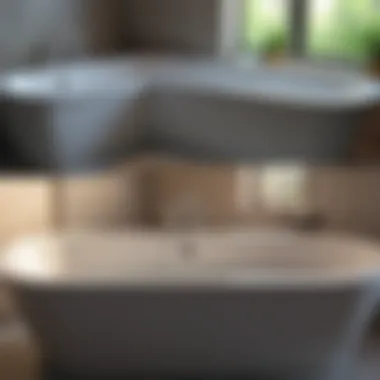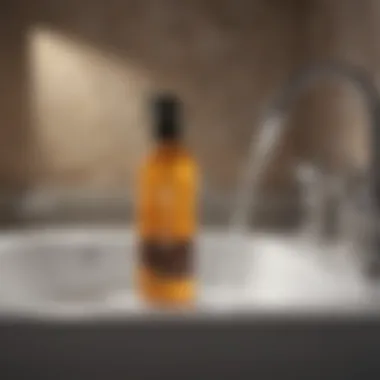Effective Methods to Remove Soap Scum from Your Tub


Intro
Soap scum is an inevitable nuisance for many who enjoy the comfort of a clean bathtub.
This unsightly residue is formed when soap combines with minerals in water, creating a dull, sticky film that can quickly become entrenched in your bathroom.
Understanding its composition and removal strategies is crucial for maintaining a fresh, hygienic space.
This guide details various effective methods for eliminating soap scum from your bathtub, whether through DIY solutions or commercial products.
Understanding Soap Scum
Soap scum is primarily composed of soap residues mixed with calcium and magnesium, which are common minerals in hard water. Over time, this mixture adheres to surfaces, making it increasingly difficult to remove. Regular cleaning can help prevent the buildup of soap scum and reduce scrubbing time.
Common Methods for Removal
DIY Cleaning Solutions
Many homeowners prefer to tackle soap scum with homemade cleaning agents. These options are generally cost-effective and use simple ingredients found in most households. Here are some effective DIY cleaning solutions:
- Vinegar and Baking Soda: This classic combination works wonders. Mix equal parts vinegar and water in a spray bottle, apply generously, and let it sit for a few minutes. Then sprinkle baking soda over the area and scrub with a non-abrasive sponge.
- Lemon Juice: The natural acidity helps break down soap scum. Apply fresh lemon juice directly onto the affected area, and let it sit for about 10 minutes before wiping clean.
- Dish Soap and Vinegar: Combine dish soap with equal parts vinegar for an effective cleaner. Spray it, let it soak, and scrub gently for effective removal.
Commercial Products
While DIY solutions are great, there are numerous commercial cleaners specifically designed for tackling soap scum. When selecting a product, look for those labeled as safe for bathroom surfaces. Popular options include:
- CLR (Calcium, Lime & Rust Remover): Effective for heavy buildup.
- Scrubbing Bubbles: Designed for easy application and quick action.
- Method Daily Granite Cleaner: A more eco-friendly choice that is still effective for soap scum.
Prevention Strategies
An ounce of prevention goes a long way in keeping soap scum at bay. Here are some strategies to consider:
- Regular Cleaning: Clean your bathtub at least once a week to prevent soap scum from accumulating.
- Rinse After Use: Encourage family members to rinse the bathtub after use. This practice can help wash away soap residues before they form scum.
- Water Softener: Consider installing a water softener if you have hard water. These systems can reduce mineral buildup, minimizing soap scum formation.
Closure
Maintaining a clean and inviting bathtub does not have to be a daunting task. By understanding the nature of soap scum and utilizing a mix of effective cleaning methods and preventative measures, homeowners can enjoy a fresh bathing experience. In this way, the battle against soap scum becomes manageable, allowing you to focus more on relaxation rather than scrubbing.
Understanding Soap Scum
In the quest for a sparkling clean bathtub, grasping the nature of soap scum becomes crucial. Soap scum is not just an aesthetic issue; it is a byproduct of the interactions between soap, water, and the minerals found in tap water. Realizing this can lead to more effective cleaning practices. By understanding what soap scum is made of, homeowners can strategize their cleaning efforts with greater precision.
What is Soap Scum?
Soap scum is a thin film that builds up on surfaces, particularly in bathtubs and sinks. It consists mainly of soap residues and hard water minerals such as calcium and magnesium. When soap does not dissolve completely in hard water, it reacts to form a sticky residue. This not only dulls the look of your bathtub but can also create an unhygienic environment.
Why Soap Scum Forms in Bathtubs?
The formation of soap scum is typically linked to the ingredients within the soap itself. When soap combines with minerals in hard water, it creates insoluble compounds that adhere to bathroom surfaces. Certain soaps, particularly those containing high fat or oil content, tend to produce more scum. Additionally, the frequency of use and overall bathroom maintenance play roles in the speed of buildup. Bathing regularly without adequate cleaning will accelerate the formation of soap scum.
Impact of Hard Water on Soap Scum Accumulation
Hard water significantly influences soap scum development. The minerals found in hard water do not only react with soap but also trap additional residues, enhancing the scum's durability. Areas with higher mineral content in their water supply will likely experience faster and more intense soap scum build-up. This makes it essential for homeowners to consider their water quality and adapt their cleaning approaches accordingly.
Understanding the composition and causes of soap scum allows for the implementation of targeted cleaning strategies.
In summary, recognizing the basics of soap scum is fundamental in establishing a cleaning regimen tailored to effectively combat its formation. Armed with this knowledge, housewives and homeowners can maintain cleaner, more pleasant bathing environments.
Initial Cleaning Preparations


Before diving into the actual cleaning process of soap scum removal, initial preparations are paramount. These steps lay the groundwork toward an effective cleaning session. Proper preparation helps streamline the process and ensure all necessary materials are at hand, ultimately making the endeavor more efficient.
Gathering Required Materials
When addressing soap scum, it is critical to gather all required materials beforehand. This not only aids in saving time but also reduces the chances of interruptions during cleaning. Here are essential items you should consider:
- Cleaning Solutions: Depending on your preference, you may choose DIY options like baking soda and vinegar, or store-bought products designed for soap scum removal.
- Scrubbing Tools: Have a non-abrasive sponge or scrub brush ready to effectively loosen the scum without damaging the tub's surface.
- Protective Gear: It is advisable to wear gloves to protect your hands from harsh chemicals and potential skin irritation.
- Container for Mixing: If you opt for homemade mixtures, a bucket or bowl will be needed for proper mixing and application.
Bringing all these materials together ensures you have everything you need, eliminating unnecessary back-and-forth during the cleaning process.
Safety Precautions
Cleaning can often involve the use of potent substances. Therefore, taking safety precautions is crucial both for your health and the cleanliness of your bathroom area. Here are some important safety tips:
- Ventilation: Ensure the bathroom is well-ventilated. Open windows or turn on exhaust fans to minimize inhalation of fumes that may come from commercial cleaners or chemical solutions.
- Read Labels: Always read the labels on products carefully. Some cleaners may contain strong acids or bases that require cautious handling and specific application methods.
- Keep Products Away from Children and Pets: It is essential to store your cleaning solutions out of reach to prevent accidental exposure.
- Avoid Mixture of Chemicals: Never mix different cleaning agents, especially products containing bleach with ammonia, as this can produce toxic gases.
"Safety should be your first concern when cleaning, especially when using potent substances."
By adhering to these initial cleaning preparations and safety measures, you set a solid foundation for removing soap scum effectively and securely. This phase of the cleaning process cannot be underestimated, as it enhances not only your success but also your overall experience.
DIY Cleaning Solutions for Soap Scum
Removing soap scum effectively is crucial for keeping your bathtub clean. Many homeowners prefer DIY cleaning solutions due to their accessibility and cost-effectiveness. These methods utilize everyday ingredients that are often already present in your kitchen, eliminating the need for harsh chemicals. Furthermore, DIY solutions can be safer for both your health and the environment. They are practical options for anyone looking to avoid the risks associated with commercial cleaners while still achieving a high level of cleanliness.
Baking Soda and Vinegar
Baking soda and vinegar make an excellent team for tackling soap scum. Baking soda's mild abrasive properties help to scrub away deposits, while vinegar acts as a natural disinfectant that breaks down mineral build-ups. To use this combination, sprinkle baking soda liberally over the soap scum-affected area. Following that, spray white vinegar directly onto the baking soda. The reaction produces bubbles, which assist in lifting the scum.
After about 15 minutes, scrub the area with a non-abrasive sponge, focusing on stubborn spots. Rinse with warm water to reveal a clean surface. Not only does this method cleanse the bathtub, but it also leaves behind a fresh scent.
Dish Soap and Baking Soda Paste
This method is another effective tactic to employ in your cleaning arsenal. The dish soap helps to break down the oily residue often found in soap scum, while baking soda adds a gentle scrubbing power. Mix three parts baking soda with one part dish soap to form a thick paste. Apply the paste directly onto the soap scum areas in your bathtub.
Let it sit for about 10 minutes to penetrate the grime. Then, take a scrubber or a cloth and scrub the area firmly but gently to avoid scratching the surface. Rinse thoroughly with warm water. This solution is particularly effective for bathrooms that experience heavy use or have residual soap buildup.
Lemon Juice and Essential Oils
Lemon juice is renowned for its natural acidity, which can help to cut through soap scum effectively. Mixing lemon juice with essential oils, like tea tree or lavender, not only enhances its cleaning properties but also infuses your bathroom with a pleasant aroma. To create this cleaning solution, combine equal parts lemon juice and water in a spray bottle, adding a few drops of essential oil if desired.
Spray the mixture generously on the soap scum area and let it sit for roughly 10 to 15 minutes. After that, wipe it down with a cloth or sponge. Rinse with water to remove any residual mixture. This method provides a fresh scent along with a thorough cleaning.
DIY cleaning solutions not only remove soap scum effectively but also promote a healthier home environment.
In summary, these DIY cleaning solutions offer various benefits, from accessibility to environmental safety. By incorporating them into your cleaning routine, you can maintain a clean and inviting bathtub.
Commercial Products for Soap Scum Removal
When addressing the persistent problem of soap scum in bathtubs, commercial products serve as an effective solution. Homeowners appreciate the convenience that these products offer. They are designed specifically for tackling soap scum, often containing active ingredients that break down the buildup quickly and efficiently.
The importance of selecting the right cleaning agent cannot be overstated. Each formulation targets soap scum differently, and understanding these elements is critical for optimal results. While some products can deliver swift and powerful action, others might require more time to achieve desired outcomes. Therefore, careful consideration must be given when choosing a soap scum remover to ensure that it aligns with individual needs and the specific conditions of the bathroom.
Furthermore, the health and safety implications of these commercial cleaners should be a priority. Many contain harsh chemicals that pose risks if not handled properly. Homeowners should be well-informed about these products, particularly if pets or children are present in the home.


In summary, the right commercial products can simplify the process of removing soap scum. However, it is essential to weigh the factors of effectiveness, safety, and suitability before making a purchase.
Choosing the Right Product
When selecting a commercial soap scum remover, several features need to be taken into account. Not all products are created equal, and understanding these differences can lead to better cleaning results.
- Active Ingredients: Look for products containing specific compounds like citric acid or surfactants, which are effective at breaking down soap scum.
- Surface Compatibility: Ensure that a cleaner is safe to use on your bathtub material, whether it’s acrylic, porcelain, or fiberglass. Avoiding damage to the surface is crucial.
- Convenience of Use: Some products are ready to use straight from the bottle, while others may require mixing with water or additional preparation.
- Odor and Environmental Impact: Consider opting for products with low levels of volatile organic compounds (VOCs) or eco-friendly choices, especially in a household with sensitive individuals.
Effectiveness of Gel Cleaners
Gel cleaners present a popular option for soap scum removal. Their thick consistency allows them to cling to vertical surfaces, enhancing dwell time on soap scum. This extended exposure increases their effectiveness in breaking down stubborn buildup.
Many users prefer gel cleaners due to their ability to maintain contact longer, often requiring less effort to scrub afterward. As they dissolve grime effectively, this minimizes the risk of needing repeated applications. While generally more expensive, gel formulations can prove to be cost-effective if used wisely.
However, while using gel cleaners, it remains vital to follow manufacturer instructions. Some formulations may require a specific contact time to achieve optimal results and may not work as effectively if applied incorrectly.
Spray Cleaners vs. Cream Cleaners
The choice between spray cleaners and cream cleaners often depends on personal preference and specific cleaning circumstances.
- Spray Cleaners: These products offer ease of application and quick spreading across large surfaces. They are ideal for regular maintenance as it's convenient to spritz over the tub and rinse away. Many spray cleaners are also designed for daily use, making them effective in preventing soap scum buildup.
- Cream Cleaners: These tend to be thicker and provide a more abrasive cleaning action. They can be ideal for tackling heavy soap scum deposits. When using cream cleaners, users often find they can achieve a deeper clean with less effort for tough spots.
Ultimately, both types of cleaners have their distinct advantages. The choice should reflect cleaning habits and the specific accumulation of soap scum in the bathtub.
Choosing the right type of cleaner can significantly affect the results achieved while also ensuring the bathtub remains in good condition.
Step-by-Step Cleaning Process
The step-by-step cleaning process is a crucial aspect of effectively removing soap scum from your bathtub. This methodical approach not only ensures that every part of the bathtub receives attention but also allows for thorough cleaning to achieve the best results. Taking time to prepare, apply the right cleaning solutions, use effective scrubbing techniques, and complete the rinsing and drying phases is essential. Each stage contributes significantly to the overall efficacy of the cleaning operation and has unique advantages that lead to a clean, soap scum-free surface.
Preparation of the Bathtub
Before starting the cleaning process, it is important to prepare the bathtub. Begin by removing any items that may be in or around the tub, such as shampoo bottles and washcloths. Ensuring an unobstructed work area allows you to clean more efficiently. Next, a preliminary rinse of the bathtub with warm water helps to loosen any debris and soap scum already present. A clean bathtub surface improves the effectiveness of the cleaning solution that will be applied later. Consider also ensuring proper ventilation. Open a window or turn on an exhaust fan, especially if you are using strong cleaning agents.
Applying Cleaning Solution
Once the bathtub is prepared, the next step is applying your chosen cleaning solution. Whether you opt for a DIY recipe or a branded commercial product, the method of application is similar. Use a spray bottle or sponge to evenly distribute the solution across the tub’s surfaces. Pay particular attention to areas where soap scum tends to build up, such as around faucets and soap dishes. Allow the cleaning solution to sit for several minutes as recommended by the manufacturer or based on your DIY recipe. This resting period is vital as it enables the active ingredients in the cleaner to break down the soap scum more effectively.
Scrubbing Techniques
After applying the cleaning solution, it’s time to scrub the bathtub. Use a non-abrasive sponge or soft-bristle brush to gently scrub the surfaces. It is important to avoid harsh scrubbing as it may damage the finish of the bathtub. Start from the top and work your way down, ensuring consistency in pressure. Focus on heavily soiled areas and use circular motions for even coverage. For stubborn spots, reapply the cleaning solution and give it another scrub. This technique will help lift and remove the hardened soap scum more comprehensively.
Rinsing and Drying
The final phase involves rinsing and drying the bathtub. After scrubbing, rinse thoroughly with clean water to remove any remaining cleaning solution and dislodged soap scum. Ensure no residue is left behind, as it can attract more dirt. After rinsing, use a clean, dry cloth to help absorb excess water and prevent water spots from forming on the surface. This step is also important as it discourages future buildup of soap scum. Consider leaving the bathtub dry and open to air after cleaning; this practice promotes better hygiene and extends the time before the next cleaning is needed.
"A clean bathtub not only enhances the bathroom's appearance but also promotes a healthier environment for your family."
Preventive Measures Against Soap Scum
Preventing soap scum can save time and effort when cleaning your bathtub. Soap scum forms from the combination of soap residue, minerals from hard water, and body oils, creating a sticky film. By understanding and implementing preventive measures, you reduce future cleaning efforts and maintain a cleaner bathing environment. This section highlights the significance of these measures and provides guidance on effective strategies.
Regular Cleaning Schedule


Having a regular cleaning schedule is essential in combating soap scum build-up. Regular maintenance limits the amount of soap residue and hard water deposits from accumulating. Here are some key points to consider:
- Cleaning your bathtub at least once a week prevents the formation of tough stains.
- Short and frequent cleanings are often more effective than infrequent deep cleans.
- Use a mild cleaner for routine wipe-downs to keep surfaces fresh without harsh chemicals.
Using Water Softening Solutions
The impact of hard water on soap scum cannot be overstated. Hard water contains high levels of calcium and magnesium, which react with soap, causing a thick film to develop. Utilizing water softening solutions can significantly reduce this issue. Consider the following benefits:
- Water softeners remove minerals that contribute to soap scum formation.
- There are several options available, including installing a whole-house water softener or using softening agents during bathing.
- Reducing hard water usage can lead to a noticeable decrease in cleaning effort over time.
Post-Bathing Practices
Instead of waiting for soap scum to build up, simple post-bathing practices can keep your tub cleaner for longer. Implementing these habits does not take much time and can provide lasting benefits.
- Rinse the tub after each use. Quickly rinsing away soap and residue prevents build-up and keeps the surface cleaner.
- Consider using a squeegee. Using a squeegee to wipe down the walls and tub after each bath can be an effective way to remove water droplets and decrease scum formation.
- Use a towel to dry the surfaces. Drying the tub after use can minimize water spots, helping to preserve its appearance.
By incorporating these preventive measures into your routine, you can lessen the frequency and intensity of cleaning required, optimizing your bathroom maintenance efforts.
Adopting a proactive approach not only preserves the look of your bathtub but also enhances your overall bathing experience.
Common Mistakes to Avoid
When it comes to removing soap scum from your bathtub, several common mistakes can undermine your efforts. Understanding these pitfalls is crucial for housewives and homeowners aiming for a clean bathroom. Avoidance of these errors not only saves time but also promotes the longevity of your bathtub's surface and enhances safety during the cleaning process.
Using Abrasive Cleaners
One prevalent mistake is the use of abrasive cleaners. Many believe that stronger is better, assuming that harsh chemicals or gritty substances can expedite the cleaning process. However, this is often not the case. Abrasive cleaners can scratch the surface of your bathtub, leading to future build-up and more stubborn stains. Instead, opt for gentler yet effective alternatives that can tackle soap scum without damaging your surfaces.
Important Note: Check the manufacturer's recommendations before selecting a cleaner. Some materials like acrylic or fiberglass require specific non-abrasive products to maintain their sheen and integrity.
Neglecting Safety Gear
Another error is neglecting safety gear during the cleaning process. Many cleaning agents, whether commercial or DIY, can contain strong chemicals that pose health risks. Ignoring safety measures such as gloves, masks, or goggles can lead to skin irritations or worse. Safety gear acts as a safeguard against any accidental splashes or inhalation of fumes. Investing a little time in ensuring proper protection can save you from unnecessary discomfort.
Allowing Products to Sit Too Long
Lastly, allowing cleaning products to sit too long on the surface can be detrimental. It may seem that leaving a cleaner on the soap scum provides it more time to work. While this might seem logical, it often results in a build-up of residues that can be challenging to remove. Follow directions carefully, and know when to rinse. It is better to reapply if needed, rather than let solutions linger longer than advised.
Avoiding these common mistakes ensures a more efficient cleaning experience. With proper techniques and consideration, you can maintain a clean and pleasant bathtub environment.
End
Summarizing Effective Techniques
The removal of soap scum requires a blend of practical methods and the right cleaning agents. DIY solutions such as the use of baking soda and vinegar or lemon juice can be highly effective due to their natural acidic properties. Commercial products also provide efficient alternatives, especially for those who prefer convenience. It is essential to match the technique to the level of buildup present in your bathtub to achieve optimal results.
Considerations for Effective Cleaning:
- Assess the degree of buildup
- Choose appropriate cleaning agents based on personal preference
- Follow detailed cleaning methods outlined previously
Using these effective techniques contributes to maintaining a fresh and clean bathing environment.
Importance of Maintenance
Maintenance plays a pivotal role in preventing soap scum from becoming a recurring problem. By implementing a consistent cleaning schedule, the accumulation of soap scum can be significantly reduced. This involves not just the act of cleaning but also understanding and adjusting to the water quality in your area. For instance, if you have hard water, integrating water softeners into your routine can help in minimizing the effect of mineral deposits.
Key Maintenance Practices:
- Establish a weekly cleaning routine
- Consider using water-softening products
- Wipe down surfaces after each use to limit buildup
Prioritizing maintenance is not only about reducing cleaning frequency but also enhancing the overall hygiene of your bathroom space. In summary, understanding effective methods and committing to routine maintenance create a practical strategy for combatting soap scum.















